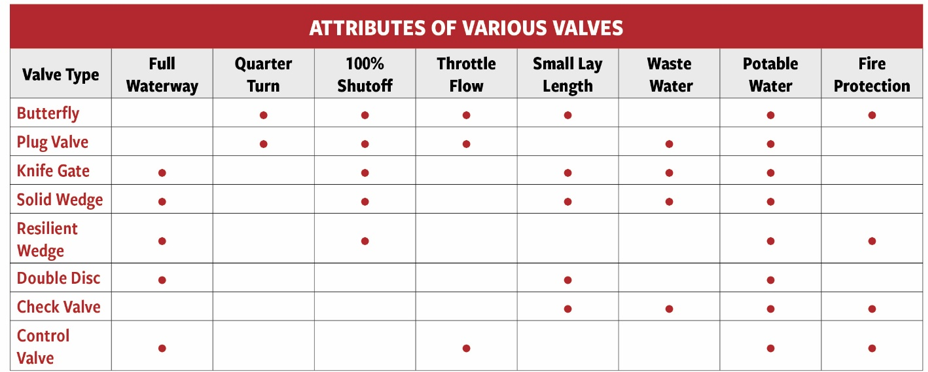Have you encountered problems post-installation due to selecting an inappropriate valve for the task?
Selecting the appropriate valve for an application is crucial to avoid complications post-installation. With a multitude of valve types available, it’s essential to evaluate various factors before making a purchase. Understanding the distinct advantages of each valve type and the specific conditions they will function in is key. The objective is to identify a valve that not only operates effectively throughout its lifespan but also represents a cost-effective solution. Within the water industry, there are three areas, each with unique valve requirements that must be carefully considered to ensure optimal performance.
Wastewater
Valves used in wastewater conditions encounter solids, sludge (thick semisolid mixture), slurry (thin semiliquid mixture), and chemicals. These valves need to be resistant to clogs and leaks. Valves that are good for this kind of environment include, Check Valves, Knife Gate Valve, Plug Valves, and Solid Wedge Gate Valves.
Potable Water
Valves in contact with potable water need to be made from materials that are safe for human consumption, and resistant to corrosion. NSF 61 is the primary certification by the National Sanitation Foundation for contact with potable water and is required by the American Waterworks Association (AWWA) for water distribution valves. Choosing a reputable manufacturer that meets AWWA standards will help with quality assurance. Valves that are good for potable water include Butterfly Valves, Check Valves, Double Disc Gate Valves, Knife Gate Valve, Resilient Wedge Gate Valves – Rising or Non-Rising Stem, Control Valves, and Solid Wedge Gate Valves.
Fire Protection – UL/FM approved Valves
Underwriters Laboratories (UL) listing and/or Factory Mutual Research approval are often required for products used in fire protection systems. Valves used in fire protection need to handle high temperatures and pressures, while providing quick operation. These valves may not be used very often but need to be reliable on the occasion they are needed. Valves that perform well here include Check Valves, Control Valves, Post Indicating Butterfly Valve and Resilient Wedge Gate Valves – Rising Stem Valves (OS&Y) or Post Indicator Valves.
Knowing the attributes of the different kinds of valves helps with selecting a suitable valve for the right environment and application. Here are key characteristics of the valves that are ideally suited for wastewater, potable water and fire protection.
- Butterfly Valves – are a quarter turn valve, making it fast to actuate. The circular disc is mounted on a stem in the center of the valve. It is also great for shutting off and regulating flow. Butterfly valves are lighter in weight and have a small lay length, making a more space efficient installation. An advantage of butterfly valves is that, in throttling applications, forces on the rotating disc are balanced allowing relative ease of operation even at high flow velocity.
- Check Valves – only allow flow in a single direction, and automatically close if the flow reverses and can open with 1 psi of pressure. Check valves eliminate back flow and are self-automated.
- Double Disc Gate Valves – have a multi turn non-rising stem. They are available with rollers tracks and scrapers to aid in clearing the waterway when closing the valve when installed on the side. They are not meant to throttle but make great shut off valves.
- Knife Gate Valves – have a gate that moves up and down allowing full flow or isolation of the line. They have a thin gate that can cut through media. Knife gate valves also have a small lay length. An advantage of knife gate valves is that they are extremely versatile. They are offered in a variety of abrasion resistant, and chemical resistant materials for applications ranging from dry powder to drinking water.
- Post Indicating Butterfly Valve – these valves are used with post indicators to show whether the valves are in the open or closed position. Otherwise, it has all the attributes of a butterfly valve being a quarter turn valve with a circular disc mounted on a stem in the center of the valve. The rotating disc is great for shutting off and regulating flow. They are lighter in weight than other types of valves and have a shorter lay length.
- Plug Valves – are a quarter turn valve that have a tight shut off. Plug valves are great for regulating flow and they function very well in high-solids applications, like sludge and slurries.
- Resilient Wedge Gate Valves – Rising or Non-Rising Stem (NRS or OS&Y) – these are multi turn actuation valves with a vertically moving metal gate that is encapsulated in rubber. OS&Y valves have visible confirmation as to whether the valve is in the open or closed position. These valves have a fully open water way with a smooth epoxy coated surfaces for maximum flow with little to no head loss. A smooth-bottom waterway allows debris and silt to pass through the valve when these valves are installed vertically. They are great shut off valves and are not meant to throttle flow.
- Resilient Wedge Gate Valves – Post Indicator Valves – these valves are used with post indicators to show whether the valves are in the open or closed position. They have all the attributes of the resilient wedge gate valve mentioned above making them great shut off valves.
- Solid Wedge Gate Valves – are muti-turn actuation that moves the gate vertically. They are available as rising and non-rising stems. Solid Wedge valves have a full flow waterway to prevent clogging and are not meant to throttle flow. The gate is made of exposed metal, making it suitable in abrasive environments and more economical. These are great shut off valves.
- Automatic Control Valves – operate by introducing or exhausting water above a diaphragm that opens and closes the valve at controlled rated. They can be used to control pressure downstream of the valve (pressure reducing), upstream of the valve (pressure sustaining), or both. The configuration of these valves makes them unsuitable for applications with any solids content and they are often used to regulate pressure in water distribution systems.









